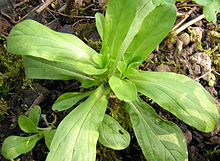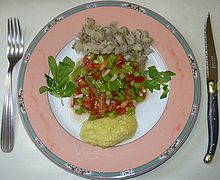- Corn salad
-
Corn Salad Corn Salad close up Scientific classification Kingdom: Plantae (unranked): Angiosperms (unranked): Eudicots (unranked): Asterids Order: Dipsacales Family: Valerianaceae Genus: Valerianella Species: V. locusta Binomial name Valerianella locusta
L.Corn salad (Valerianella locusta (Linnaeus) or Valerianella olitoria (Moench) - the synonym Valeriana is obsolete but appears frequently in older texts) [1] [2] is a small dicot annual plant of the family Valerianaceae. It is also called Lewiston cornsalad, lamb's lettuce, fetticus, field salad, mâche, feldsalat, nut lettuce and rapunzel. [3]
Contents
Description
Corn salad grows in a low rosette with spatulate leaves up to 15.2 cm long.[3] It is a hardy plant that grows to zone 5, and in mild climates it is grown as a winter green. In warm conditions it tends to bolt to seed.[4]
Corn salad grows wild in parts of Europe, northern Africa and western Asia.[5] In Europe and Asia it is a common weed in cultivated land and waste spaces. In North America it has escaped cultivation and become naturalized on both the eastern and western seaboards.[6]
History
Corn salad was originally foraged by European peasants until the royal gardener of King Louis XIV, de la Quintinie, introduced it to the world.[7] It has also been used as food in Britain for many centuries and appears in John Gerard's Herbal of 1597 but only became commercially available there in the 1980s. [8] It was grown commercially in London from the late 18th/early 19th century and appeared on markets as a winter vegetable. See 'Vegetables and their Culivation', Sanders, T. W. 1917. The common name corn salad refers to the fact that it often grows as a weed in wheat fields. [8]
Nutrition
Like other formerly foraged greens, corn salad has many nutrients, including three times as much vitamin C as lettuce, beta-carotene, B6, B9, vitamin E, and omega-3 fatty acids. It is best if gathered before flowers appear.[2]
References
- ^ USDA Germplasm Resources Information Network (GRIN) [1]
- ^ a b Ed. David A. Bender (2005) Dictionary of Food and Nutrition, Oxford University Press
- ^ a b Floridata: Valerianella locusta
- ^ Plants for a Future: Valerianella locusta
- ^ United States Department of Agriculture: Germplasm Resources Information Network
- ^ United States Department of Agriculture Natural Resources Conservation Service: Plants profile for Valerianella locusta
- ^ Organic Gardening Magazine, August-September 2007
- ^ a b Ed. John Ayto (2002) An A-Z of Food and Drink, Oxford University Press
Sources
- This article incorporates text from the public domain 1911 edition of The Grocer's Encyclopedia.
Categories:- Leaf vegetables
- Valerianaceae
Wikimedia Foundation. 2010.



